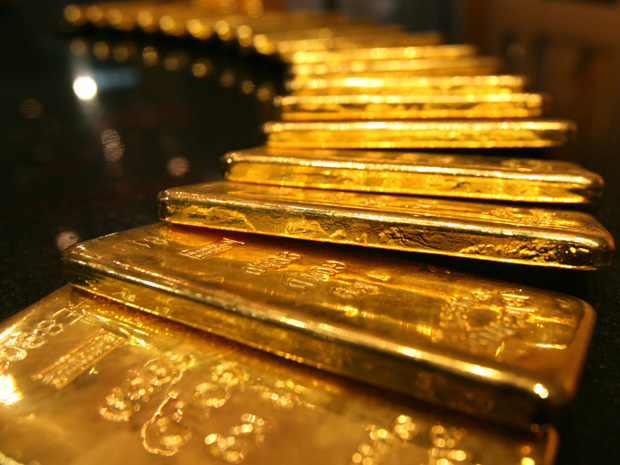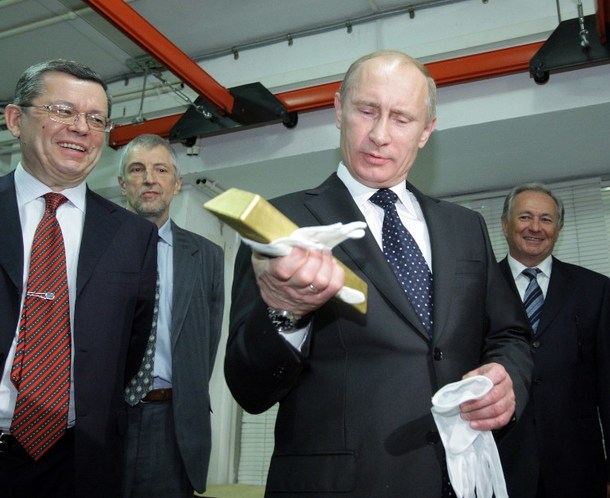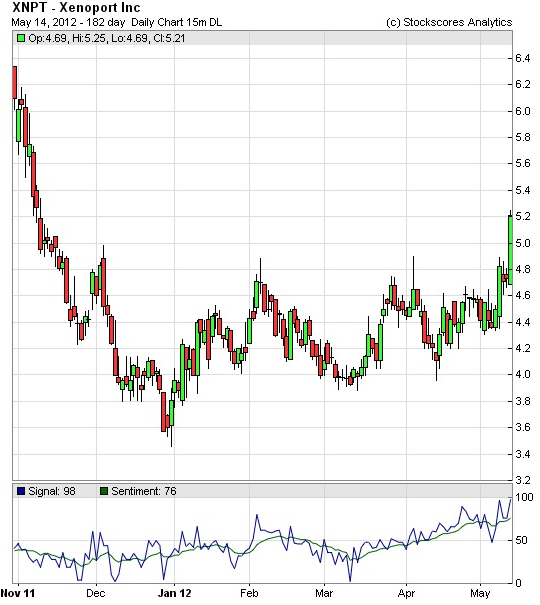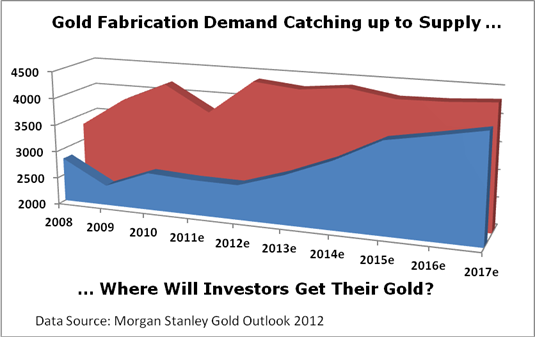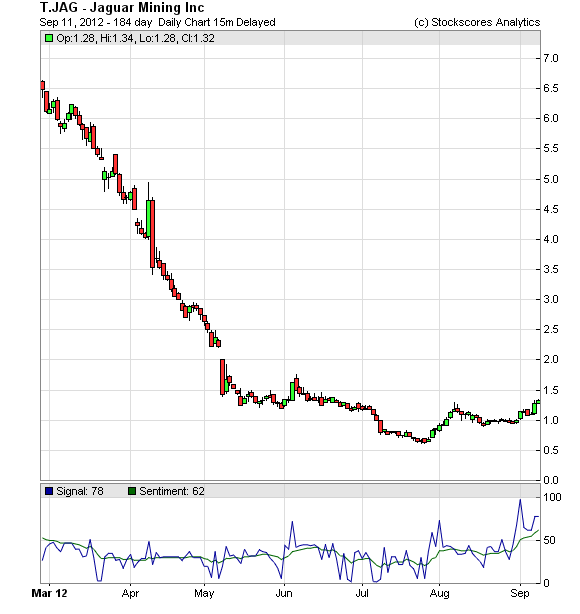The Gold Report: Eric, why is there a bear market for metal mining companies in a season of bulls?
Eric Coffin: Post-recession, there was a good bounce for commodity stocks. Two problems have slowed things down during the last year. One was fear of the fiscal cliff as the politicians in Washington argued about raising the debt ceiling. Banks were blowing up in Europe. Most important, weakening numbers out of China scared off a lot of investors, particularly from the base metals. There are simply a lot of people concerned about the economy in general, and, specifically, the growth economies where metals are keys to industrial development.
On the gold and silver side, the real issue is that gold is over $1,700/ounce (oz) and silver is now over $30/oz. It sounds as if I’m being ironic, but I’m not. At the start of this major cycle, gold prices were $300/oz. It was not the price-earnings (P/E) ratio that was determining the value of a lot of mining companies, it was the P/E ratio plus a very large amount added for in-the-ground resources. Goldbugs at the start of this cycle expected gold and silver prices to go up 500%. They were as interested, if not more interested, in the leverage, the “ounces in the ground per share” that gold stocks represented.
I’m not going to assume that gold is going to $10,000/oz. I’d be really happy if it does, but I’m not expecting it. What we are seeing now is that the P/Es for the gold firms are returning to the market average. In the past, gold companies could trade at 80–90 P/E. The earnings part didn’t matter very much. It was all about the amount of gold resources on hand. Now investors are taking a harder look at how much money these firms are actually making. We can’t just assume that gold is going up another 400–500%. So the P/Es have normalized.
Another concern is profit margins. Costs have gone up very rapidly in the mining business. For a long time that was because there was a skills shortage. Part of the reason why we expected this to be a long secular bull market was because we knew how short the industry was on all kinds of skills, material and equipment. The mining sector was not going to turn around and suddenly start producing twice as much copper, zinc or whatever at the same cost. As the price of metals rises, so does the price of a geologist, the price of an engineer, the price of a ball mill.
The situation will improve over time as more professionals are trained and the production capacity of industry suppliers is increased, but this takes time. The final piece of the cost equation for many metals is grade. As the “low hanging fruit” is picked and the industry moves to tougher terrain with less infrastructure and deposits with lower average grade, the cost of production rises. While I’m not a big believer in things like “peak copper” (at least not any time soon), supply is very much a function of price. If the world wants ever increasing amounts of metals it will have to pay up and pay the mining industry to supply them. The days of cheap metals, in most cases, are over.
TGR: You observed recently in HRA Journal that the currently depressed junior gold explorer market is showing signs of life. Can you explain that?
EC: One reason is that the market is running out of sellers. People who wanted out of gold equities are largely gone; there is a huge amount of money on the sideline. That puts in a bottom but doesn’t cause a turnaround. I think the spark that gets the juniors moving again, as it has in many past cycles, is new discoveries. We haven’t seen many discoveries that grabbed the market’s attention in the last couple of years.
Exciting discovery stories are critical to the junior mining sector. People need to be reminded of why they buy these high risk stocks. Investors do not buy a $0.10/share junior as a widow or an orphan stock, they buy it because they are swinging for the fences. It’s hard for investors to talk themselves into swinging for the fences unless they are seeing others hitting one out of the park.
A couple of recent home runs have generated a bit more liquidity in the market, but not as much as I’d like to see. The summer is always slow. The real test is going to come in the next month or two. However, we are starting to see financings close again. And companies that have done well off of drill discoveries are getting big increases in stocks prices and, critically, we are seeing more of these companies maintaining higher prices; that generates money that gets redeployed.
TGR: Let’s talk about the discoveries.
EC: GoldQuest Mining Corp. (GQC:TSX.V) is a big win for me. David and I had specifically advised people to buy GoldQuest for its drill program and then it made an amazing blind discovery in the Dominican Republic. The best drill hole at this new zone, Romero, is on the order of 235 meters (m) of almost 8 grams/ton (g/t) gold and 1.5% copper. It has reported seven holes in a small area, but doesn’t understand the geometry yet. It started out with small stepouts in an area measuring about 100x100m and is now starting larger stepouts. Not only are the grades strong, but also the zone is thick. GoldQuest is looking at 200–250m+ intercepts, and all of the holes have bottomed in the zone. The small area drilled should contain over a million ounces and it’s still wide open. That is a pretty impressive discovery, and GoldQuest stock reacted accordingly. It was $0.07/share when it announced the first drill hole. It’s about $1.60/share now. It has raised $20 million in the last month and a half, most of that at $1.25/share.
GoldQuest will drill the heck out of this. It has two drill rigs going. There’s a third one in customs, which should be onsite in a week, and a fourth rig on the way. And, the success of this target increases the value of its other targets. For instance, it has 40 kilometers (km) of contiguous holdings covering a rock formation called the Tireo Volcanics. With cash from the new discovery in hand, GoldQuest can and will up its exploration budget on that set of properties that have several other early stage discoveries in addition to Romero.
TGR: Are you following any particular gold miners in North America?
EC: In the Yukon, ATAC Resources Ltd. (ATC:TSX.V) is putting out really good holes. Kaminak Gold Corp. (KAM:TSX.V) is also putting out good holes, although it is not putting them out as often as I would like. It has obviously gone to the whole batching idea.
I also really like the look of Comstock Metals Ltd. (CSL:TSX.V). It is operating on the other side of the Yukon River from the Golden Saddle discovery. Golden Saddle was discovered by Underworld Resources Inc. (UW:TSX) four years ago, which kicked off the whole Yukon area play. It was subsequently taken out by Kinross Gold Corp. (K:TSX; KGC:NYSE). Kinross hasn’t published a new formal gold resource number, but the jungle telegraph says it’s between 2.25–2.5 Moz.
Comstock has the same rocks and very similar mineralization on the other side of the Yukon River, the north side. It is about 15 km away. It put out a very strong 75m trench about a month and a half ago, averaging 3.75 g/t. Last week, Comstock put out another set of trench results, extending the zone to almost 400m of strike length on surface. The average thickness is probably 70–80m. It compares quite favorably to Underworld’s discovery. That was followed a few days later by the announcement of a drill start. This is in the far North. Just how much drilling gets completed this fall is weather dependent but based on those trenches, it’s a strong-looking target.
TGR: Are there other explorers in northern Canada that have your eye?
EC: On the opposite corner of the Yukon, there are really high-grade numbers—up to hundreds of grams per tonne gold—coming from Northern Tiger Resources Inc.’s (NTR:TSX.V) 3Ace project this year. The company drilled several short holes in this new one but hasn’t released results yet. The main question is how big is this thing? The deposit will have to be thick to get the market excited, but the grades are high enough that the tonnage could be small and yet still prove to be profitable.
TGR: What about in the U.S.? Any names there?
EC: I have liked Premier Gold Mines Ltd. (PG:TSX) for several years. It has developed nice land positions in Nevada and in Ontario. It’s a good story at many levels, and it has one of the best management groups in the junior sector. Premier has several very good advanced projects in Ontario and Nevada where it’s growing resources with ongoing exploration. It’s a very solid stock with a wide following.
Evolving Gold Corp. (EVG:TSX; EVOGF:OTCQX; EV7:FSE) is drilling a project in the same area of Nevada as Premier. It has put out some good holes and some not-so-good holes. It needs to drill a range of deep holes to figure out the geometry. But it definitely has a Carlin zone. And in the Carlin mineralization, the gold tends to be very fine grained. It requires a lab assay. But there’s no real shortcut for getting the wedge holes done in order to figure out which direction to chase the zone and determine if the one is large enough to justify larger drill programs.
TGR: How does a smart investor in gold juniors separate the wheat from the chaff?
EC: It’s wise to focus on a geographic area that’s already generated a lot of good news. If a company is looking for a bulk tonnage open-pit-type deposit, I look at the target size to be sure there is enough scale potential. I don’t have a problem with the high-grade ore. Good high grade deposits can be very profitable even though the market tends to focus on the big low grade systems. But to get the market’s attention for an underground operation, there needs to be a minimum of 6–8 g/t and, ideally, more than 10 g/t in intercepts.
In many areas you can make money on lower grades than that if there is good thickness but the market tends to ignore grades below 10 grams unless they are at least several meters thick. With bulk tonnage, you can get away with 1 g/t or 1.5 g/t, but for drilling at those grades, you want to see 60, 80, 100m drill intercepts. The property has to look strong from the outset, because the company has to keep raising money. That being the case, one looks for a management group with a strong brand and a track record of success—both in market terms and in technical terms.
Things can get difficult even when a discovery has been made if management isn’t able to get the market to take notice. Having access to capital is huge for a junior. It’s even more critical when the market is weak as it has been the past 18 months. When the market’s great, everybody’s happy, people will say “yes” to anything and it’s much easier to raise money. But when the market is weak, management must be able to convince people to write a check. Of the 1,500 or so junior companies, there may be 100 that can do that in this type of market on non-dilutive terms and no more.
TGR: How’s it going with Precipitate Gold Corp. (PRG:TSX.V), which is in both the Dominican Republic and the Yukon?
EC: I’m pretty happy with it. By way of disclosure, as you know, Precipitate was founded by my late brother, David, and me and our friend Scott Gibson. We were very fortunate to be joined from the start by such a strong board and management team. Adrian Fleming is the chairman; he ran Underworld before it was taken out and has huge business credibility. The board includes Quinton Hennigh, a good friend and one of the smartest geologists I’ve ever met. Both Adrian and Quinton know how to talk to the market. Our friend Gary Freeman is also on the board. Gary is a great financier. David and I had been involved with him in the early development of Pediment Gold Corp. (PEZ:TSX; PEZGF:OTCBB;P5E:FSE), which was taken out by Argonaut Gold Inc. (AR:TSX). Darryl Cardey, who was the chairman of Underworld, is also on the Precipitate board of directors. Darcy Krohman, another longtime friend who has the unusual combination of dual professional standings both as a P. Geo geologist and a CA, is the president.
Due to its very credible management team, Precipitate was able to do a $0.40/share initial public offering on early-stage, Yukon properties in May with no warrants. Believe me, that wasn’t a piece of cake. People bought the stock as a bet on management. Though we like the Yukon projects, it was no secret everyone involved with the company was, and still is, on constant lookout for projects that would be accretive and add value to the company.
As it happens, just before Precipitate listed, GoldQuest made its discovery in the Dominican Republic. I’m very good friends with Bill Fisher and Julio Espaillat, who run it. I’ve always liked that belt of rocks. And it is not an exaggeration to say that GoldQuest and Gold Fields Ltd. (GFI:NYSE) invented the Tireo as an exploration destination. They did the regional work that focused on those rocks and the belt has generated several discoveries in its short 10 year exploration history. If Precipitate had said six months ago, “Hey, we have a property next to GoldQuest,” most people would have said, “Who the hell is GoldQuest?” Now, it’s a different story.
As soon as its first drill hole was announced, I was trying to find projects in the right rocks for Precipitate. That is not easy to do because the belt was largely tied up even before the Romero discovery, but we were lucky to get a large concession that has the right geology along its eastern side bordering Goldquest. This is early stage exploration but it’s a great address and Romero is already looking as if it could be a world class discovery after only seven drill holes.
TGR: Let’s pull out and look at the macroeconomic level for a minute. What kinds of economic triggers are likely to affect gold equities positively or otherwise in the foreseeable future?
EC: For the next three months, it’s central banks, central banks and central banks. Everybody is expecting Federal Reserve Chairman Ben Bernanke to kick in Qualitative Easing 3 (QE3). I’m slightly less convinced, but I’m not going to complain if he turns on the printing press. The latest monthly employment report in the U.S. was quite weak so that may be the trigger for a QE announcement. What Bernanke said at Jackson Hole brought the gold price back up through $1,700/oz. We are seeing similar indications out of the European Central Bank (ECB). Mario Draghi is telling the European countries that are anti-stimulus, “I’m going to do it with you, or without you!” And Germany’s Chancellor Angela Merkel, who hasn’t exactly been a proponent of bond buying, is now saying they have to stimulate. It looks like we could have stereo printing presses humming along on both sides of the Atlantic before long.
Perversely, weak employment numbers and weak purchasing manager index numbers help precious metals. Weak economic indicators convince traders that Bernanke and the ECB are going to have to pull the trigger. On the base metals side, the easing could have the opposite impact, with one exception. If we continue to see weak numbers out of Beijing, the traders will think that Beijing is going to stimulate, too. But not with bond buying. The Chinese can simply loosen reserve requirements for the banks. They hold trillions of dollars in foreign reserves. Unlike Washington and most of the debtor countries in Europe, China can simply start writing checks. It, too, has been putting out weaker numbers and making more noise about stimulating. China does have slightly higher inflation, which makes things trickier, but I expect it to step up stimulus toward year-end as the next generation of Communist Party leadership is sworn in.
TGR: What effect would QE3 have on mining interests, generally?
EC: It will help. QE3 will weaken the U.S. dollar. It will cause traders to buy treasuries all the way up and down the yield curve, thereby lowering the yields. In the last couple of weeks, the U.S. dollar index has dropped a couple of points, which is a fairly big move. As it moves lower, gold and silver prices in U.S. dollars will strengthen. Then we will see better numbers in the U.S. as businesses gain confidence and start hiring. Those hiring decisions are being held back right now because managers aren’t comfortable with the slow growth rate. Virtually all traded commodities are priced in U.S. dollars, so it should help them all, though precious metals will get the biggest, quickest boost.
TGR: How will monetary easing affect mining in Mexico?
EC: In Mexico, the peso is relatively weak by historic standards, which helps with mining costs. It has good mining infrastructure and good mining legislation. It doesn’t have any real royalties to speak of. You don’t get a lot of surprises there. However, areas of the country are bloody dangerous; that’s the one thing that has held Mexico back recently. The drug cartels have scared people out of some areas. Nobody really knows who is calling the shots. You certainly don’t get the impression that it is the Federales; the drug cartels do whatever they want. But people more or less know where the growing is and where the drug routes are, so they stay out of those areas. I’d like to think that crime is not going to be a long-term problem. There are still plenty of areas in Mexico that work out fine for miners.
You must have agreements with the local ejitos, however. Although the ejitos don’t own the mineral rights, they do have surface rights and they have local political power. So you need to sit down, talk to the locals and make sure that everybody is happy, because an angry ejito can really make your life miserable. There are some ejitos who just don’t want development. And when the locals don’t want you, there’s just no point in bothering. All that said, it’s a good country with lots of good geology and plenty of recent discoveries. If the government can get the crime issue under control, I don’t doubt the high level of mining investment would continue and probably grow again.
TGR: Are there any other companies that you think are hot?
EC: I’d keep an eye on Reservoir Minerals Inc. (RMC:TSX.V). Its joint venture with Freeport-McMoRan Copper & Gold Inc. (FCX:NYSE) is pulling some amazing drill holes in Serbia. It just put out the second one today—the copper equivalent was almost 10% through 160m. That’s a heck of a drill intersection. Freeport is not fooling around. It is doing big stepouts. It wants to know right away if it’s the real thing and already has four drill rigs at work.
At a more advanced level, I like EurOmax Resources Ltd. (EOX:TSX.V). It is in several countries in Eastern Europe, including Serbia. It has a new management group that came directly out of European Goldfields Ltd. (EGU:TSX; EGU:AIM), which was taken out about a year ago for about $1.5 billion. These guys have huge credibility, especially with European institutions. Euromax is drilling to expand Ilovitza, a copper-gold porphyry in Macedonia. It has a couple of nice projects that have gold resources on them, but there is room for some more gain simply by the current management group going around and telling the story. Management views the asset set as very comparable to that of European Goldfields Ltd. (EGU:TSX; EGU:LSE) but with one tenth the current market value.
Speaking of Mexico, if you’re interested in a production level story we like SilverCrest Mines Inc. (SVL:TSX.V; SVLC:NYSE.MKT). We have followed the company since inception. I have a very high regard for the management team, which has been delivering on time and on budget for years. SilverCrest is generating nice profits from its Santa Elena gold-silver mine in Sonora and plans are in the works to add a mill to this heap-leach operation and start mining deeper parts of the system and double the production rate by 2014. SilverCrest is also drilling its La Joya bulk tonnage silver-base metal project in Durango. There should be an updated resource estimate by the end of the year and it looks like it’s going to be big, probably close to 200 Moz silver equivalent. SilverCrest has gotten a lot of traction as gold and silver prices jumped recently but if they keep going up, the company should too.
Lastly, HRA is offering a free report for your Gold Report readers. It’s actually our latest HRA Journal,which discusses in more detail some of the companies that we have covered in this interview, such as Precipitate Gold, Comstock Metals and GoldQuest. To access the report for FREE, all you need to do is sign up through our page at HRAdvisory and you’ll automatically receive a copy of the Journal via email.
TGR: Thanks, Eric.
EC: You’re welcome.
Eric Coffin is the editor of the HRA (Hard Rock Analyst) family of publications. He has a degree in corporate and investment finance and extensive experience in merger and acquisitions and small-company financing and promotion. For many years, he tracked the financial performance and funding of all exchange-listed Canadian mining companies and has helped with the formation of several successful exploration ventures. Coffin was one of the first analysts to point out the disastrous effects of gold hedging and gold loan-capital financing in 1997. He also predicted the start of the current secular bull market in commodities based on the movement of the U.S. dollar in 2001 and the acceleration of growth in Asia and India. Coffin can be reached at hra@publishers-mgmt.com or the website www.hraadvisory.com.
Want to read more exclusive Gold Report interviews like this? Sign up for our free e-newsletter, and you’ll learn when new articles have been published. To see a list of recent interviews with industry analysts and commentators, visit our Exclusive Interviews page.
DISCLOSURE:
1) Peter Byrne of The Gold Report conducted this interview. He personally and/or his family own shares of the following companies mentioned in this interview: None.
2) The following companies mentioned in the interview are sponsors of The Gold Report: Comstock Metals Ltd., Premier Gold Mines Ltd., Evolving Gold Corp., Precipitate Gold Corp., Argonaut Gold Inc. and SilverCrest Mines Inc.Streetwis Reports does not accept stock in exchange for services. Interviews are edited for clarity.
3) Eric Coffin: I personally and/or my family own shares of the following companies mentioned in this interview: Precipitate Gold Corp., Comstock Metals Ltd., Kaminak Gold Corp., Goldquest Mining Corp., EurOmax Resources Ltd., Reservoir Minerals Inc., SilverCrest Mines Inc., Northern Tiger Resources Inc. and Argonaut Gold Inc. I personally and/or my family are never paid by any of the companies followed by HRA. I was not paid by Streetwise Reports for participating in this story.
